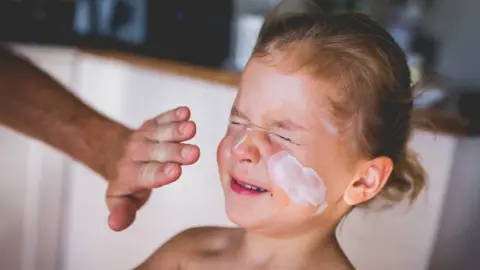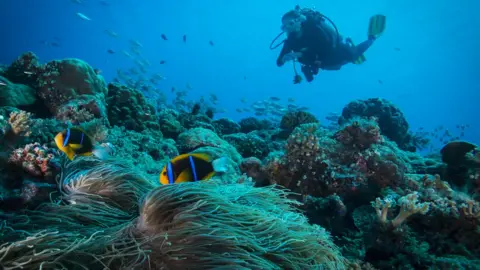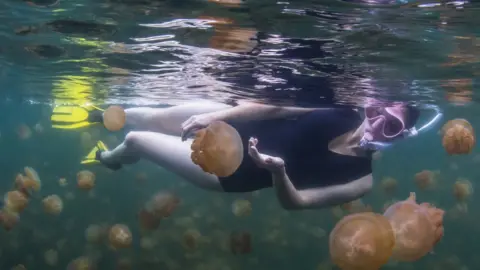Coral: Palau to ban sunscreen products to protect reefs
 Getty Images
Getty ImagesPalau is set to become the first country to impose a widespread ban on sunscreen in an effort to protect its vulnerable coral reefs.
The government has signed a law that restricts the sale and use of sunscreen and skincare products that contain a list of ten different chemicals.
Researchers believe that these ingredients are highly toxic to marine life, and can make coral more susceptible to bleaching.
The ban comes into force in 2020.
In a statement, Palau's President Tommy Remengesau said the ban, which would see fines of $1,000 (£760) for retailers who violated the law, was timely.
"The power to confiscate sunscreens should be enough to deter their non-commercial use, and these provisions walk a smart balance between educating tourists and scaring them away."
How do sunscreen products harm corals?
Scientists have been raising concerns about the impacts of sunscreen products on marine life for many years.
They are particularly worried over the role of two ingredients called oxybenzone and octinoxate. These are used as sun protection factors as they absorb ultraviolet light.
However, they are believed to make coral more susceptible to bleaching. Research published in 2015 showed that the oxybenzone could stunt the growth of baby corals and was toxic to several different coral species in laboratory tests.
"Oxybenxzone is probably the baddest actor out of the 10 chemicals that have been banned," said Dr Craig Downs, an expert on the impacts of sunscreens on marine life.
"It causes corals to bleach at lower temperatures, and it reduces their resilience to climate change."
Dr Downs says that when there's a disastrous event like mass coral bleaching, reefs should recover over the following years. That has not been happening in many parts of the world.
 Global_Pics
Global_Pics"Life doesn't scramble back in where there are tourists," said Dr Downs. "The juvenile phase of coral are more susceptible to chemical pollution than adults. That's why we see these areas not coming back."
"They are coral reef zombies. Only the adults are left and it's only a matter of time before they go."
How much of a threat does sunscreen pose?
Researchers say that the biggest threat to coral reefs is climate change, with estimates that 90% of reefs will succumb to rising temperatures by 2050. The second biggest threat is the suffocating threat posed by algal blooms, triggered by the runoff of nutrients from sewage and farming. Sunscreen is now seen as one of a number of other, lesser threats including ocean acidification.
 Global_Pics
Global_PicsHow widely used are the banned sunscreen chemicals?
It has been estimated that between 6-14,000 tonnes of sunscreen wash off people and go into reef areas every year. Researchers say that several thousand sun protection products contain the two most threatening chemicals.
Five years ago it was estimated to be in around 75% of products. Experts now say it's found in about half of creams and lotions.
Right now the US Congress is looking at legislation to ban oxybenzone, based on the threat it poses to human health.
Why Palau and why now?
Palau is located in the western part of the Pacific ocean. It is made up of one large volcanic island and several smaller coral reef associated islands. Despite its small size, it has often taken big steps in protecting the environment.
In 2015, it designated almost its entire ocean territory as a marine protected zone. Very aware of the threats of climate change, Palau became the second nation in the world after Fiji to ratify the Paris climate agreement in 2016.
When it comes to coral reefs, the island nation has largely avoided the negative impacts of extensive coastal erosion from agriculture, pollution and rampant overfishing that have affected reefs elsewhere.
The ban on sunscreen products means Palau is determined to fight any threat to the reefs, which are visited by thousands of tourists every year.
Prof Jörg Wiedenmann, who studies coral ecosystems at the University of Southampton, UK, said: "It is a sensible precaution to prevent the exposure of the vulnerable corals from the potential threats by sunscreen products in these places.
"However, reefs cannot be saved by banning sunscreens alone. There are more destructive drivers of reef decline such as sea water warming, overfishing, nutrient enrichment and pollution that need to be controlled to halt the ongoing degradation of reef ecosystems."
Has anyone else looked to ban sunscreen with these ingredients?
Yes - several regions have imposed bans, including the island of Bonaire in the Caribbean and the US state of Hawaii which passed a law earlier this year. Mexico has banned sunscreen in nature reserves.
 Getty Images
Getty ImagesThe Palau restriction is set to be the most comprehensive yet, covering 10 chemicals. They include four that have an antimicrobial effect but have also been shown in the scientific literature to act as endocrine disruptors.
Experts say that dozens of other countries may now look to replicate the Palau ban.
Are there alternatives that don't contain these chemicals?
Yes, there are alternatives that don't include the two key chemicals that are being marketed as "reef-safe". But some scientists argue that the term is not legally enforceable, and there is no compulsion on manufacturers to demonstrate that their products don't harm coral.
Dr Craig Downs says the first line of protection against the sun should be clothing with built-in sun protection.
"From a conservation point of view, if you wear a sun shirt, you are reducing the sunscreen load by 50%. That's a major conservation victory."
Another approach would be to use mineral-based sunscreen, such as non-nanosized titanium oxide or zinc oxide.
How are sunscreen manufacturers reacting?
Many of the larger corporations are against a ban on sunscreen products, saying that the evidence of a detrimental impact on coral is not strong enough.
"The big boys are fighting it. Johnson & Johnson and L'Oreal don't seem to be on board," said Dr Downs.
"But much of the rest of the industry have already come out with what they are calling 'Hawaii-compliant sunscreen', and it is a big marketing boost for them."
A group of manufacturers have formed what they call the Safe Sunscreen Council. They welcomed the move.
"Palau's move to ban ingredients that have been know to cause damage to coral reefs is the right things to do," said Caroline Duell from the council.
"Hopefully, by Palau taking leadership on this issue, not only will they protect their sacred and economically key coral reef network, but they will show the world that it's time to change the way we think. There are many alternatives for sunscreen and personal care products that are safe, effective and enjoyable to use."
